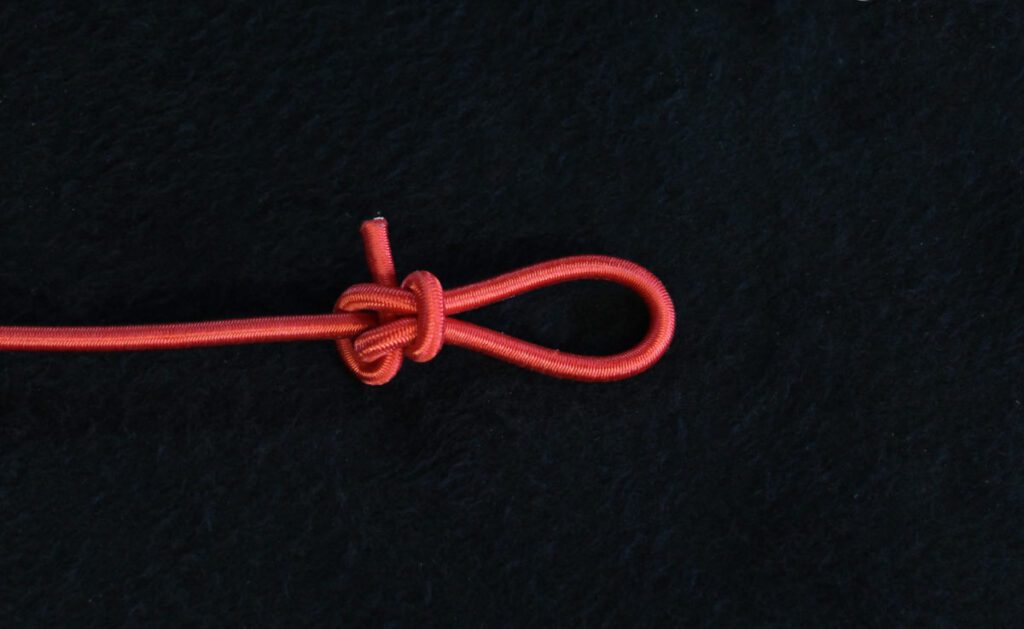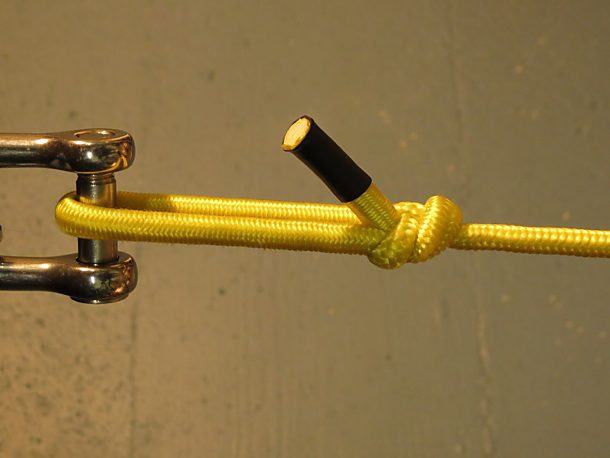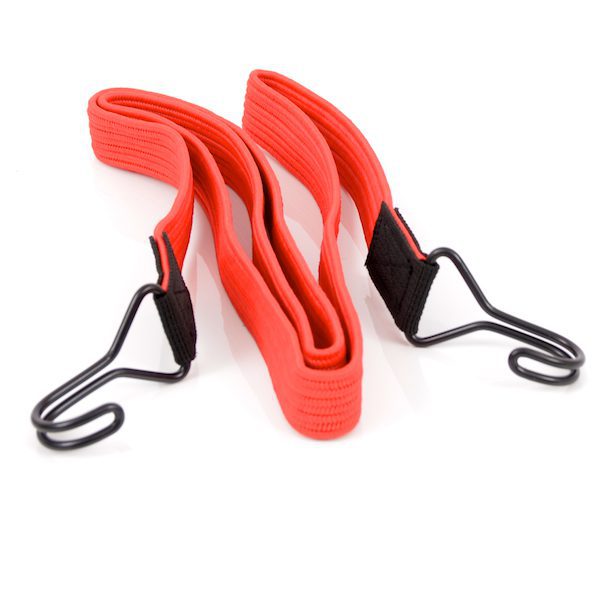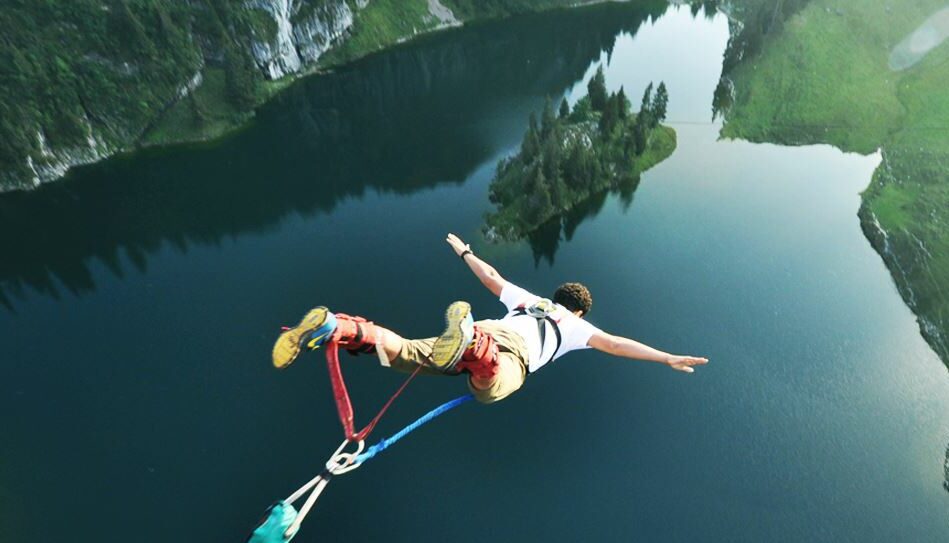Looking for a versatile and flexible tool to secure your gear and equipment? Bungee cords are a popular choice for outdoor enthusiast and DIY enthusiasts alike. However, tying bungee cords can be tricky without the right techniques and knowledge. In this blog post, we’ll explore the limitations and customization techniques for various applications, as well as the Zeppelin Bend and Angler’s Loop knots tailored for bungee cords. We’ll also provide a step-by-step guide on creating bungee tethers and anchors, along with helpful tips on using bungee bands, loops with toggles, and adjustable toggles. Whether you’re a seasoned pro or a beginner, our expert advice and custom bungee cord solutions will help you get the most out of your bungee cords. So, let’s dive in and learn how to tie bungee cords like a pro!
Exploring the Versatility of Bungee Cord Knots and Accessories

Bungee cord knot
Bungee cords are a popular choice for a wide range of applications due to their flexibility, durability, and elasticity. However, to fully harness their potential, it is essential to understand the art of tying the right knots and utilizing appropriate accessories. In this section, we will delve deeper into the world of bungee cord knots and accessories, exploring their versatility and providing practical tips for boating, camping, and DIY enthusiast.
When working with bungee cords, it is crucial to select the appropriate knot for the task at hand. For instance, the Zeppelin Bend and Angler’s Loop are two knots that excel in different scenarios. The Zeppelin Bend is an excellent choice for joining two bungee cords end-to-end, creating a secure and stable loop. This knot is particularly useful in situations where you need to extend the length of your bungee cord, such as when securing larger loads or creating a makeshift clothesline at a campsite.
On the other hand, the Angler’s Loop is ideal for creating a fixed loop in a bungee cord, similar to a bowline. This knot is perfect for attaching a bungee cord to a fixed point or creating a secure loop for hanging items. However, it is essential to note that the Angler’s Loop is prone to jamming and may not be suitable for situations where you need to untie the knot later.
Pro tip: To prevent jamming, consider applying a small amount of lubricant, such as silicone spray, to the bungee cord before tying the Angler’s Loop. This will make it easier to untie the knot when necessary.
In addition to mastering the art of knot-tying, it is also beneficial to familiarize yourself with various bungee cord accessories. For example, bungee bands, loops with toggles, and adjustable toggles can be used to secure loads or tie things down in place of knots. Hog rings and hog ring pliers are also useful tools for crimping bungee cords, allowing you to create custom lengths and configurations for your specific needs.
For those seeking expert advice and custom bungee cord solutions, the Bungee Store offers a wealth of information and resources. From custom orders to guidance on using bungee cords in various activities and household projects, the Bungee Store is an invaluable resource for both beginners and seasoned enthusiasts alike.
In conclusion, understanding how to tie bungee cord knots and use accessories effectively can significantly enhance your experience with this versatile tool. By mastering the Zeppelin Bend, Angler’s Loop, and other essential knots, as well as exploring the various accessories available, you can tackle a wide range of tasks with confidence and ease.
Bungee Cord Limitations and Customization Techniques for Various Applications

Bungee cord knot
Bungee cords have gained popularity for their elasticity and versatility in various applications, especially in the boating and camping industries. However, you might find that pre-cut bungee cords with metal hooks or plastic balls at the ends do not always match the requirements of specific tasks. The stretchiness of bungee cords can make them either too short or too long, which demands creative solutions to ensure optimal functionality. Traditional knots, such as the sheet bend or bowline, will not hold well in bungee cords since they are made for ropes with less stretch. Customizing bungee cords using hog rings and heat-shrink tubing can create a durable fastening solution for your needs. Moreover, acquiring long lengths of bungee cords and cutting them to size will allow for more personalized applications. In this article, we will discuss the best knots and tying techniques for bungee cords, ensuring secure anchor points and tethers that can be undone with ease when necessary.
One of the main challenges when using bungee cords is finding the right balance between their elasticity and the tension required for a specific task. For instance, when securing a load on a boat or a vehicle, you want the bungee cord to be tight enough to hold the load in place, but not so tight that it risks snapping or damaging the items being secured. This is where customization techniques come into play.
Instead of relying solely on pre-cut bungee cords, consider investing in a bulk spool of bungee cord material, which allows you to cut cords to the exact length needed for your application. This not only saves you money in the long run but also gives you the flexibility to create custom bungee cords for various purposes.
Another customization technique involves using alternative fasteners, such as carabiners, S-hooks, or snap hooks. These can be easily attached to the ends of your bungee cords, providing a more secure and adjustable connection than traditional metal hooks or plastic balls. You can also create your own fasteners using materials like PVC pipes or even 3D-printed components, giving you even more control over the design and functionality of your bungee cords.
When it comes to tying knots with bungee cords, it’s essential to use techniques that are specifically designed for their unique properties. As mentioned earlier, the Zeppelin Bend and Angler’s Loop are two such knots that work well with bungee cords, providing a secure and reliable connection without the risk of slipping or coming undone. By mastering these knots and other bungee cord-specific techniques, you’ll be able to tackle a wide range of tasks with confidence and ease.
In conclusion, understanding the limitations of bungee cords and learning how to customize them for various applications is crucial for maximizing their potential. By experimenting with different knots, fasteners, and cutting techniques, you can create tailor-made solutions that perfectly suit your needs, ensuring that your bungee cords always provide the right balance of elasticity and tension for any task at hand.
Mastering the Art of Bungee Cord Knots: The Zeppelin Bend and Angler’s Loop
When it comes to working with bungee cords, tying the right knot can make all the difference in achieving a secure and reliable connection. The Zeppelin Bend and Angler’s Loop are two knots that have been specifically designed for use with bungee cords, offering unique advantages in various situations.
Why Traditional Knots Fall Short with Bungee Cords
One might wonder why traditional knots, such as the square knot or the sheet bend, are not suitable for bungee cords. The answer lies in the material properties of these cords. Bungee cords are typically made of elastic materials, such as rubber or latex, which can cause traditional knots to slip or come undone under tension. This is where the Zeppelin Bend and Angler’s Loop come in, offering secure and reliable alternatives tailored for bungee cords.
Choosing the Right Knot for the Task at Hand
When selecting the appropriate knot for your bungee cord application, it’s essential to consider the specific requirements of the task. The Zeppelin Bend is ideal for joining two bungee cords together, enabling the creation of a larger loop or extending the length of an existing cord. This knot is particularly useful when securing large or irregularly shaped objects that require additional cord length for proper fastening.
Read all about: Jumpstart Your Fitness Routine: A Complete Guide on How to Set Up Bungee Fitness at Home
On the other hand, the Angler’s Loop is perfect for creating a fixed loop in a bungee cord, offering a secure attachment point for gear or other items. This knot is especially helpful when you need to fasten a bungee cord around an anchor point, such as a hook, carabiner, or eyelet. Despite its occasional tendency to jam, the Angler’s Loop provides a reliable hold in situations where untying the knot later is not a priority.
Practice Makes Perfect: Mastering Bungee Cord Knots
As with any skill, mastering the art of tying bungee cord knots requires practice and patience. Begin by familiarizing yourself with the steps involved in tying the Zeppelin Bend and Angler’s Loop, and then practice these knots with different bungee cord types and thicknesses. Over time, you’ll develop a strong understanding of which knot is best suited for various scenarios and how to tie them quickly and efficiently.
By learning and mastering the Zeppelin Bend and Angler’s Loop, you’ll unlock the full potential of bungee cords, ensuring a secure and reliable connection for a wide range of applications. So, go ahead and put your newfound knot-tying skills to the test – you’ll be amazed at the versatility and convenience that these specialized knots can bring to your bungee cord projects.
Creating Bungee Tethers and Anchors: A Step-by-Step Guide
When it comes to securing and organizing gear, bungee cords are invaluable tools. In this section, we will explore how to create bungee tethers and anchors using the Angler’s Loop and Zeppelin Bend knots, ensuring your equipment stays safe and secure.
Creating Bungee Tethers for Various Applications
Bungee tethers are useful for a wide range of applications, including securing gear on boats, bikes, or camping trips. Follow these simple steps to create a bungee tether:
- Create an Angler’s Loop at one end of the bungee cord.
- Pass the loop through or around the gear you want to secure.
- Pull the other end of the bungee cord through the loop and tighten it.
- Ensure that the cord is adequately secured around the gear before moving on to the next step.
For added versatility, you can also create a bungee tether by tying a rope to a bungee cord using the Zeppelin Bend. This combination is especially useful when you need to secure items that may require more length or additional support.
Anchoring Bungee Tethers for Maximum Stability
Anchoring your bungee tether is crucial for ensuring the stability and security of your gear. Here’s how to anchor a bungee tether using the Angler’s Loop:
- Create an Angler’s Loop at one end of the bungee cord.
- Choose an anchoring point, such as a cleat or rail on a boat.
- Pass the loop through the anchoring point and pull the other end of the bungee cord through the created loop.
- Tighten and secure the bungee cord.
Remember that the strength and stability of your anchor point are just as important as the knots you use. Always choose a solid, reliable anchoring point to ensure the safety of your gear.
Adapting Bungee Tethers for Unique Situations
While the Angler’s Loop and Zeppelin Bend are excellent knots for most bungee cord applications, there may be situations where you need to adapt your tether or anchor. In these cases, consider using alternative fasteners or customizing your bungee cords with hog rings and heat-shrink tubing to create the perfect solution for your needs.
In conclusion, mastering the art of creating bungee tethers and anchors will significantly enhance the versatility and usefulness of your bungee cords. By understanding how to use the Angler’s Loop and Zeppelin Bend knots effectively, you can secure your gear with confidence, knowing it will stay safe and stable in any situation.
Helpful Tips on Using Bungee Bands, Loops with Toggles, and Adjustable Toggles
Bungee cords can be accompanied by various accessories that further enhance their versatility and ease of use. Here are some helpful tips and insights on making the most of these accessories.
Bungee Bands: A Gentle Alternative

Bungee strap
Bungee bands, often referred to as flat bungee cords, are a fantastic alternative to traditional round cords. Their wider surface area allows for a more even distribution of pressure, making them ideal for securing delicate items or loads that require a consistent hold. For instance, bungee bands can be used to secure tarps over garden furniture, preventing damage caused by excessive pressure points. They are also great for bundling irregularly shaped items together, as their flat design can easily contour around objects, providing a secure grip.
Loops with Toggles: DIY Customization
If you find that the plastic balls at the end of pre-cut bungee cords aren’t meeting your needs, consider creating your own loops with toggles. These homemade toggles can be made from plastic pipe or even a sturdy wooden dowel, offering an adjustable option for stopper knots. This customization allows you to create the perfect tension for your specific task, ensuring that your gear stays securely fastened. To make a loop with a toggle, simply thread the bungee cord through the pipe or dowel and tie a secure knot. This will create a loop that can be adjusted to fit various applications.
Adjustable Toggles: Fine-Tuning Your Bungee Cord
For those looking to achieve an even higher level of customization, adjustable toggles are a must-have accessory. These toggles can be easily moved along the length of the bungee cord and locked into place, allowing you to create the exact tension needed for your task. This feature is particularly useful when securing loads on roof racks or bike racks, as it ensures that your gear remains tightly fastened during transport. To use an adjustable toggle, simply thread the bungee cord through the toggle’s opening and slide it to the desired position. Once you’ve found the perfect spot, lock the toggle in place, and you’re good to go!
In conclusion, bungee cords are incredibly versatile tools that can be easily customized to suit a wide range of applications. By incorporating bungee bands, loops with toggles, and adjustable toggles into your toolkit, you can ensure that you’re always prepared for any task that comes your way. Remember to practice proper knot-tying techniques and use the appropriate accessories to fully harness the potential of your bungee cords.
Seeking Expert Advice and Custom Bungee Cord Solutions
When embarking on a project that requires the use of bungee cords, it is crucial to seek expert advice and explore custom bungee cord solutions. The Bungee Store is an excellent resource for this, as their team of professionals can provide guidance and support in selecting the most suitable bungee cords, knots, and accessories for your specific needs, be it boating, camping, or general DIY projects.
One of the most significant advantages of seeking expert advice is the opportunity to learn from experienced professionals who have encountered various challenges and found effective solutions. They can share their insights and tips on how to avoid common mistakes and achieve optimal results with your bungee cord applications. For instance, they can help you choose the right type of cord material, thickness, and length based on your project requirements, ensuring you have the best-suited tool for the job. For more similar posts like this visit our blog and check out Get Back on Your Feet: How to Safely Return to the Platform After Bungee Jumping and Jumping into the Facts: Bungee Jumping Weight Limits and Safety Precautions.
Furthermore, custom bungee cord solutions can be invaluable in situations where standard, pre-cut cords may not be sufficient. Experts can guide you in creating bespoke cords tailored to your specific needs, such as incorporating additional accessories like carabiners, hooks, or rings. This customization allows for greater versatility and adaptability, making your bungee cord applications more efficient and effective.
Another aspect to consider when seeking expert advice is the opportunity to learn proper maintenance and storage techniques for your bungee cords. Proper care can significantly extend the lifespan of your cords, ensuring they remain safe and reliable for future use. Experts can provide guidance on how to inspect cords for wear and tear, clean them appropriately, and store them safely to prevent damage or deterioration.
Lastly, by engaging with professionals, you can stay up-to-date with the latest innovations and advancements in bungee cord technology. This knowledge can help you make informed decisions when selecting cords and accessories, ensuring you always have access to the most effective and efficient solutions for your projects.
In summary, seeking expert advice and exploring custom bungee cord solutions can greatly enhance your ability to utilize bungee cords effectively. By tapping into the knowledge and experience of professionals, you can ensure that you are well-equipped to tackle any project that requires the use of bungee cords, knots, and accessories, ultimately leading to more successful outcomes.
FAQ & Fans Questions
These types of bungee cords are limited in certain applications on a boat and can be challenging to work with if they are either too short or too long.
The Zeppelin Bend and Angler’s Loop are two knots that work well with bungee cords, and both can be easily untied.
The Zeppelin Bend is a knot that starts with two overhand loops and creates interwoven half-hitches when tightened. It is used to join two bungee cords end-to-end and create a loop that is stable and resistant to jamming.
The Angler’s Loop is another knot that can be used to tie bungee cords to important gear. It creates a fixed loop in a bungee cord, holds well, but is prone to jamming and not suited for untying later.
Homemade toggles are made from plastic pipe and are preferred over plastic balls for stopper knots.
The Bungee Store offers custom orders and advice for using bungee cords in a variety of activities and household projects.

